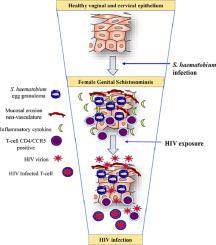当前位置:
X-MOL 学术
›
Acta Trop.
›
论文详情
Our official English website, www.x-mol.net, welcomes your feedback! (Note: you will need to create a separate account there.)
Beyond the barrier: Female Genital Schistosomiasis as a potential risk factor for HIV-1 acquisition.
Acta Tropica ( IF 2.7 ) Pub Date : 2020-05-13 , DOI: 10.1016/j.actatropica.2020.105524 A S Sturt 1 , E L Webb 2 , S C Francis 2 , R J Hayes 2 , A L Bustinduy 1
Acta Tropica ( IF 2.7 ) Pub Date : 2020-05-13 , DOI: 10.1016/j.actatropica.2020.105524 A S Sturt 1 , E L Webb 2 , S C Francis 2 , R J Hayes 2 , A L Bustinduy 1
Affiliation

|
Female genital schistosomiasis (FGS) results from egg-deposition in the female reproductive tract primarily by the waterborne parasite Schistosoma (S.) haematobium, and less commonly by Schistosoma (S.) mansoni. FGS affects an estimated 20-56 million women worldwide, mostly in sub-Saharan Africa. There is cross-sectional evidence of increased HIV-1 prevalence in schistosomiasis-infected women, but a causal relationship between FGS and either HIV-1 acquisition or transmission has not been fully established. Beyond the pathognomonic breach in the cervicovaginal barrier caused by FGS, this narrative review explores potential mechanisms for a synergistic relationship between S. haematobium infection, FGS, and HIV-1 acquisition through vaginal inflammation and target cell recruitment.
中文翻译:

超越障碍:女性生殖器血吸虫病是HIV-1感染的潜在危险因素。
女性生殖器血吸虫病(FGS)是由女性生殖道中的卵沉积所致,主要是由水生寄生虫血吸虫(S.)血球引起的,而较少见于曼氏血吸虫。FGS影响了全世界大约20-56百万妇女,其中大多数在撒哈拉以南非洲。有横断面的证据表明血吸虫病感染妇女的HIV-1患病率增加,但是FGS与HIV-1的获取或传播之间的因果关系尚未完全确立。除了由FGS引起的宫颈阴道屏障的病原学突破外,本篇叙事综述还探讨了通过阴道炎症和靶细胞募集而使链球菌感染,FGS和HIV-1获得之间协同关系的潜在机制。
更新日期:2020-05-13
中文翻译:

超越障碍:女性生殖器血吸虫病是HIV-1感染的潜在危险因素。
女性生殖器血吸虫病(FGS)是由女性生殖道中的卵沉积所致,主要是由水生寄生虫血吸虫(S.)血球引起的,而较少见于曼氏血吸虫。FGS影响了全世界大约20-56百万妇女,其中大多数在撒哈拉以南非洲。有横断面的证据表明血吸虫病感染妇女的HIV-1患病率增加,但是FGS与HIV-1的获取或传播之间的因果关系尚未完全确立。除了由FGS引起的宫颈阴道屏障的病原学突破外,本篇叙事综述还探讨了通过阴道炎症和靶细胞募集而使链球菌感染,FGS和HIV-1获得之间协同关系的潜在机制。



























 京公网安备 11010802027423号
京公网安备 11010802027423号